In the superorganism that is the honey bee hive, you have your worker bees, your drones (male bees), your brood, and of course her majesty the queen bee. But what about the king bee? Is there one?
No, a beehive does not include a king bee. Why do you ask? – It’s simple, the bees’ caste system community has very specific roles. These roles are allocated to all the bees that live in the hive at any given time. There may be no King bee in the hive, there are however often 100’s of drone bees, whose primary purpose is to mate with the big boss, the queen bee.
Now that we know only drones, (and not just one King bee) exists in a beehive, read on as we delve into how drones play their critical role in the world of bees.
A Drones’ Role In A Hive
The drones’ existence is for one reason only; his mission is to mate with an unfertilized virgin queen bee. This is the primary and the only role of a drone in a hive. What this means is, apart from fertilizing the queen, the drone is quite useless to the colony.
They don’t gather nectar or pollen, as they are not equipped with body parts to complete this task as the worker bees are. They don’t produce beeswax, and are not involved in taking care of the larvae, nor does it do nursing tasks for young bees. He does not protect the colony and cannot even sting because he does not have a stinger.
How Can You Identify a Drone?
With the large eyes on top of his round head that are twice the size of worker bees and queens, drones are easily recognizable.
The drone is heavy-bodied and his abdomen is stouter than that of worker bees. He weighs about 200mg, just about the same as the queen bee. He has long legs, which are almost invisible as they are hidden by his chubby tummy. The wings are very large and cover his stomach completely.
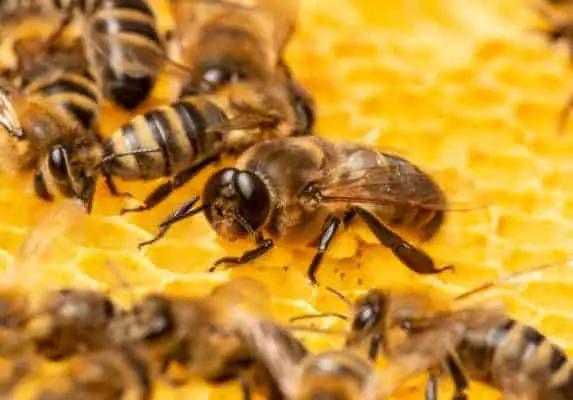
In essence, a drone is a noticeably bigger bee than a worker bee.
Drones hang around the hive during the spring and summer. They will regularly leave the hive to find Drone Congregation Areas (DCAs) with the sole purpose of being part of a mating flight.
Drone Behavior Inside The Hive
Drones are sometimes considered to be ‘layabouts’. Studies of several marked drone bees inside a beehive have shown that they spend a great deal of time, nearly three quarters, in apparent inactivity. From time to time, drones will break these long periods of monotony by uninspiring movement over the combs.
During the first few days of their lives, drones are fed entirely by worker bees. They then graduate to being both fed by worker bees, although to a lower extent than previously, as well as feeding themselves from honey cells.
At one week old, the drones feed themselves entirely and no longer beg food from worker bees. The age of drones appears to determine the behavior of worker bees towards them.
Interestingly, as some of the older drones are often attacked by worker bees, the younger drones present are at the same time still being fed. The workers who attack the drones are thought to be unemployed foragers.
As a beekeeper, when you look inside a hive, more often than not, you will find drones on the outskirts of the brood and not near the brood. The drones, lots of them, will likely be hanging out together, usually on one or two frames at the very edge of the colony.
A drone has a life expectancy of 90 days.
However, in late autumn, drones are basically kicked out from the hive by worker bees. First, the worker bees weaken the drones by denying them honey or pollen to eat. In this weakened state, they are dragged out of the hive.
After being evicted they are left to starve or hunted by predators. If they were allowed to stay, they would squander precious honey which the hive needs to winter over.
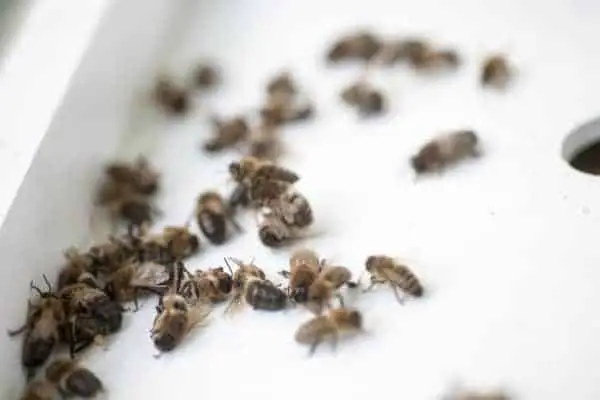
Drones begin to reappear in the hives in spring and their population reaches its peak just in time to coincide with the swarm season. Honey bees swarm in late spring and early summer.
So when do drones get to do some useful work for the hive? When the hive gets too warm, bees will fan it using their wings to cool it down. If it gets cold in the hive, the bees generate heat by vigorously vibrating their abdomens to maintain the right hive temperature at 35°centigrade.
Drones help in this task using their large bodies. So, in spite of some beekeepers that may tend to look at drones as ‘worthless’, drones do have a role in a beehive community.
Queen Mating And Genetic Diversity
As aforementioned, drones will leave the hive during spring and summer. They head for the areas known as Drone Congregation Areas (DCAs). Drones fly to these specific areas every mating season to do their thing with virgin queen bees.
Up to 25,000 drones from different hives or nests will fly for 1 to 2 kilometers to the DCA. Before flying out to mate, a drone loads his greater sized body with honey. He then heads out for a 20 to 30-minute flight to the DCA.
The DCA is usually about 10 to 40 meters above the ground. Provided the weather is warm and sunny in the afternoon, with little or no wind, this is a good time for drones to fly out. The drones can’t stay out for too long on any one particular flight. They need to fly back to the hive to feed in order to sustain their energy levels.
A virgin queen that flies into the DCA is likely to be noticed by the drones congregated in this area because she releases pheromones that are detected by the drones. However, if she flies slightly outside of the radar of the DCA, it is likely she will go undetected.
When competing to mate with a queen, the drones do not fight. The drones that manage to fly closest to the queen get the best chance to successfully mate.
Drones’ large eyes play a big role here by offering excellent vision during a flight in the quest to mate. In the DCA, a drone has a 1 in 1000 chance of mating with the virgin queen bee.
The drone that mates with the queen straddles her from above while in flight. He grasps her with all six legs, averts his endophallus by using his abdominal muscles and hemostatic pressure, and inserts it into the queen’s reproductive tract.
His ejaculation is immediate and happens with such explosive force that the tip of his endophallus is left inside the queen and causes his abdomen to rupture. The drone falls to the ground and dies shortly after.
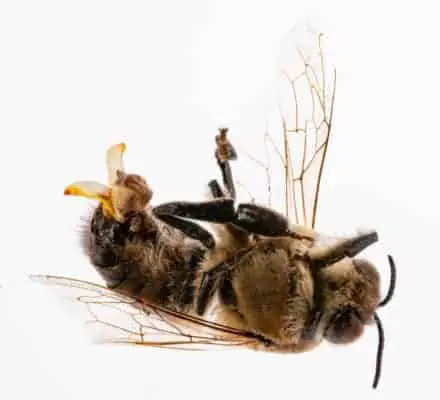
Mating is completed within 1 to 2 seconds between a single drone and the queen. Other drones will continue competing for the chance to mate.
Genetic Diversity
Up to 20 drones can mate with the queen on her one nuptial mating flight. However, it is worth noting that if she doesn’t get properly mated on one mating flight, the queen bee has been known to do a few more mating flights.
A properly mated queen bee can store up to 6 million sperms in her spermatheca. This is where sperm collected during her mating flights is stored.
By mating with drones from numerous colonies in the DCA, the queen broadens the genetic pool of her future offspring. This fundamental requirement is very important for the colony and has positive benefits to the health of the colony. One such benefit is the greater ability of the colony to resist disease.
Because a healthy queen can live up to 5 years and lay 2000 eggs a day during peak seasons, it benefits the hive to have a strong productive colony that maintains enough populations of worker bees and brood.
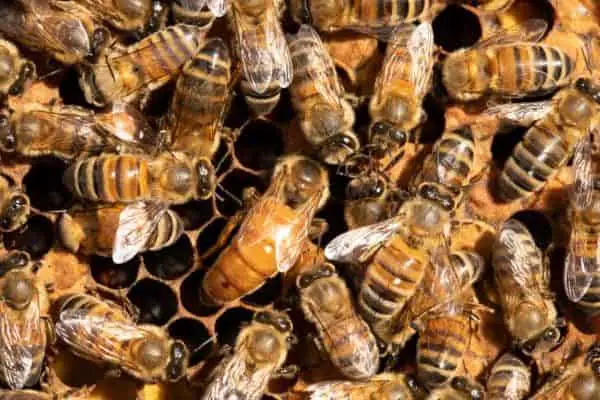
Relationship Between the Queen and Worker Bees
In a hive, worker bees that are all sterile females take on the tasks of feeding, cleaning, nursing, and defending the colony. The only fertile female bee in the colony is the queen.
The superorganism that is the hive colony is held together by a single entity; the queen bee and the pheromones she emits. A pheromone is a chemical substance that is secreted by a member of a species. It can be used to control or inhibit the behavior of another member of the same species.
In a hive, the retinue of worker bees attending to the queen spread the Queen Mandibular Pheromone (QMP) throughout the hive using their antennae.
This is one of the most important sets of pheromones produced by the queen in a hive. It signals to the hive the presence of the queen and gives the colony a sense of belonging. By the secretions that she emits, all the bees in the hive are able to identify her; drones, worker bees, and most probably other queens.
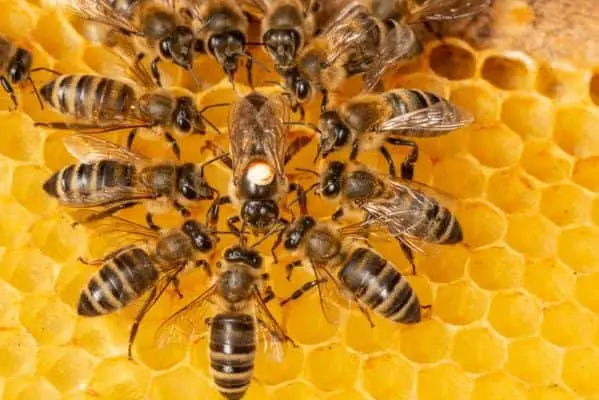
A laying queen will make twice the amount of QMP made by a newly emerged queen. Study suggests that foraging worker bees don’t appear to be attracted to QMP. Because of the little queen pheromone that they appear to have, virgin queens do not often appear to be recognized by workers.
The QMP affects the social behavior, maintenance of the hive, swarming, mating behavior and inhibition of ovary development in worker bees.
The Wrap Up
The queen, as we have seen in this article, is heavily dependent upon workers to take care of her. She can’t even digest her own food. Workers must digest it for her first and then feed it to her. Her daily activities, from her mating flight to her regular, consistent egg-laying prowess, everything she does, is very directed and regimented.
The worker bees have overall control of the queen. They have the ability to raise a new queen. If a queen’s egg-laying ability diminishes or her QMP dips, the worker bees can kill her and raise a new one from a carefully selected egg. However, the queen controls the laying of eggs and when she will lay. Her pheromones hold the colony together. Without the queen the hive cannot survive.
The drones’ role is primarily to mate. A drone can’t be King in the hive caste community; hence there is no King Bee, only a Queen Bee.
References
https://www.beeculture.com/finding-dcas/
https://en.wikipedia.org/wiki/Drone_(bee)#Anatomy
https://www.mdbka.com/bee-information/
https://www.perfectbee.com/learn-about-bees/the-life-of-bees/role-of-the-drone-bee
https://www.ncbi.nlm.nih.gov/pmc/articles/PMC3227730/
https://bees.techno-science.ca/english/bees/life-in-a-hive/drone.php
